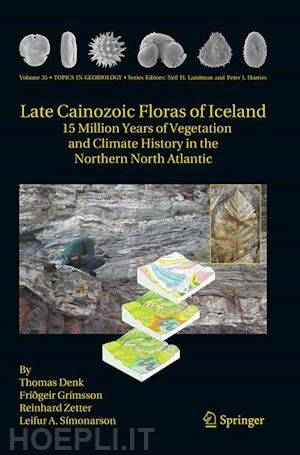
Questo prodotto usufruisce delle SPEDIZIONI GRATIS
selezionando l'opzione Corriere Veloce in fase di ordine.
Pagabile anche con Carta della cultura giovani e del merito, 18App Bonus Cultura e Carta del Docente
Being the only place in the northern North Atlantic yielding late Cainozoic terrestrial sediments rich in plant fossils, Iceland provides a unique archive for vegetation and climate development in this region. This book includes the complete plant fossil record from Iceland spanning the past 15 million years. Eleven sedimentary rock formations containing over 320 plant taxa are described. For each flora, palaeoecology and floristic affinities within the Northern Hemisphere are established. The exceptional fossil record allows a deeper understanding of the role of the “North Atlantic Land Bridge” for intercontinental plant migration and of the Gulf Stream-North Atlantic Current system for regional climatic evolution.
’Iceland sits as a “fossil trap” on one of the most interesting biogeographic exchange routes on the planet - the North Atlantic. The fossil floras of Iceland document both local vegetational response to global climate change, and more importantly, help to document the nature of biotic migration across the North Atlantic in the last 15 million years. In this state-of-the-art volume, the authors place sequential floras in their paleogeographic, paleoclimatic and geologic context, and extract a detailed history of biotic response to the dynamics of physical change.’
Bruce H. Tiffney, University of California, Santa Barbara
’This beautifully-illustrated monograph of the macro- and microfloras from the late Cenozoic of Iceland is a worthy successor to Oswald Heer’s “Flora fossilis arctica”. Its broad scope makes it a must for all scientists interested in climatic change and palaeobiogeography in the North Atlantic region. It will remain a classic for years to come.’
David K. Ferguson, University of Vienna
Chapter 1. Introduction to the Nature and Geology of Iceland
Chapter 2. A brief Review of Palaebotanical Research in Iceland
Chapter 3. Systematic Paleobotany
Chapter 4. The Archaic Floras (15 Ma)
Chapter 5. The Classic Surtarbrandur Floras (12 Ma)
Chapter 6. The early Late Miocene Floras (10 Ma) – First Evidence of Cool Temperate and Herbaceous Taxa
Chapter 7. The middle Late Miocene Floras (9-8 Ma) – A Window into the Regional Vegetation Surrounding a Large Caldera
Chapter 8. A Lakeland Area in the Late Miocene (7-6 Ma)
Chapter 9. A late Messinian Palynoflora with a distinct Taphonomy
Chapter 10. Pliocene Terrestrial and Marine Biota of the Tjörnes Peninsula – Warm Climates and Biogeographic Re-arrangements
Chapter 11. The Pleistocene Floras (2.4-0.8 Ma) – Shaping the Modern Vegetation of Iceland
Chapter 12. The Biogeographic History of Iceland – The North Atlantic Land Bridge Revisited
Chapter 13. Climate evolution in the northern North Atlantic – 15 Ma to present
Chapter 14. Art Meets Science – The Unpublished Drawings by Carl Hedelin and Thérèse Ekblom
Thomas Denk (*1969) is a palaeobotanist at the Swedish Museum of Natural History, Stockholm. His research focuses on diversification patterns and evolution of Northern Hemispheric plant groups, both modern and fossil. In addition, he is interested in the vegetation and climate history of the Northern Hemisphere during the Cainozoic, in particular the differentiation of modern temperate, Mediterranean, and eastern continental biota in western Eurasia.
Friðgeir Grímsson (*1976) currently holds a Senior Post-doc position at the Department of Palaeontology, University of Vienna, Austria. He received his Ph. D. in geology/palaeontology from the University of Iceland, Reykjavík. The focus of his research has been the origin, evolution, and biogeographic affinities of Icelandic Cainozoic floras. Currently, he is studying the impact of global cooling following the Mid-Miocene climatic optimum on European palynofloras.
Reinhard Zetter (*1955) is Associate Professor at the Department of Palaeontology, University of Vienna, Austria, where he also received his Ph. D. in Palaentology/Palynology. He established new methods for studying dispersed fossil pollen (single grain method) using light and scanning electron microscopy and is a world leading expert in palaeopalynology.
Leifur A. Símonarson (*1941) is Professor of Palaeontology at the Institute of Earth Sciences, University of Iceland. The focus of his research has been on the Cainozoic marine invertebrate fauna of Iceland and Greenland, and migration patterns and evolution of selected molluskan groups in the Northern Hemisphere.











Il sito utilizza cookie ed altri strumenti di tracciamento che raccolgono informazioni dal dispositivo dell’utente. Oltre ai cookie tecnici ed analitici aggregati, strettamente necessari per il funzionamento di questo sito web, previo consenso dell’utente possono essere installati cookie di profilazione e marketing e cookie dei social media. Cliccando su “Accetto tutti i cookie” saranno attivate tutte le categorie di cookie. Per accettare solo deterninate categorie di cookie, cliccare invece su “Impostazioni cookie”. Chiudendo il banner o continuando a navigare saranno installati solo cookie tecnici. Per maggiori dettagli, consultare la Cookie Policy.